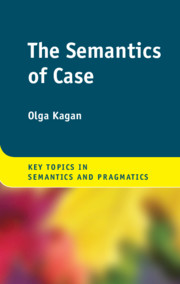Book contents
- The Semantics of Case
- Key Topics in Semantics and Pragmatics
- The Semantics of Case
- Copyright page
- Dedication
- Contents
- Figures
- Tables
- Acknowledgments
- Abbreviations
- 1 Introduction
- 2 Dative Case
- 3 Spatial Cases
- 4 Case and Aspect
- 5 Differential Object Marking
- 6 The Genitive/Accusative Alternation in Balto-Slavic
- 7 Predicate Case
- 8 Generalizations and Conclusions
- Terminology
- Bibliography
- Index
6 - The Genitive/Accusative Alternation in Balto-Slavic
Published online by Cambridge University Press: 02 April 2020
- The Semantics of Case
- Key Topics in Semantics and Pragmatics
- The Semantics of Case
- Copyright page
- Dedication
- Contents
- Figures
- Tables
- Acknowledgments
- Abbreviations
- 1 Introduction
- 2 Dative Case
- 3 Spatial Cases
- 4 Case and Aspect
- 5 Differential Object Marking
- 6 The Genitive/Accusative Alternation in Balto-Slavic
- 7 Predicate Case
- 8 Generalizations and Conclusions
- Terminology
- Bibliography
- Index
Summary
Chapter 6 is dedicated to the non-canonical genitive case-marking on objects in Balto-Slavic languages, concentrating primarily on Russian facts. It deals with the genitive/accusative alternation on direct objects and, to a lesser degree, the genitive/nominative alternation on subjects. First, Genitive of Negation and Intensional Genitive are discussed. The two phenomena, which involve genitive case-assignment to the object of a negated or intensional verb, are unified under the term Irrealis Genitive. The chapter considers those properties that affect the choice of case, including definiteness, scope, number, abstractness, and a range of syntactic and semantic analyses that have been proposed to account for the case alternations. Second, we take a look at Partitive Genitive. Here, the genitive object is interpreted quantificationally, indicating an indeterminate amount of the matter denoted by the noun. Characteristics of the phenomenon, such as homogeneity of the object and perfectivity of the verb, are listed, and two accounts are considered: one positing that the non-canonical genitive is assigned by a phonologically empty quantifier and the other treating genitive objects as nominal measure predicates. The chapter also discusses the relation between non-canonical genitive case and DOM.
Keywords
Information
- Type
- Chapter
- Information
- The Semantics of Case , pp. 189 - 222Publisher: Cambridge University PressPrint publication year: 2020
